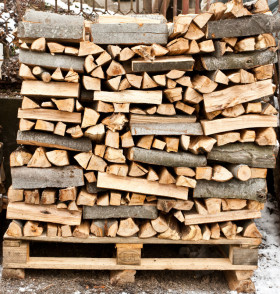Make sure your firewood is properly stored
You know the importance of properly seasoned firewood: It allows your fires to burn hot and efficiently, returning as much heat as possible to your home and reducing the amount of creosote the builds up in your chimney. Improperly stored wood also is susceptible to mold growth, which can infest your home when you bring the wood inside. If you take the time to properly season you firewood or make sure to purchase properly seasoned wood, that work is going to waste if you’re not properly storing your firewood during the winter.
When determining how best to store your firewood for the winter, there are a few factors to consider.
How much space the wood will require
The amount of wood needed to burn fires all winter can take up a considerable amount of space. The average home with a woodstove burns three cords of wood each winter. Each cord of wood takes up 128 cubic feet, or an area that is four feet deep, four feet tall and 8 feet long.
When determining where to store your firewood, you’ll first need to determine how much space it will take. Do you burn the average three cords of wood, or do you burn fires less frequently? Do you purchase all of your wood at once, or do you purchase one cord at a time, as needed? Make sure you select a space to store your wood that will suit your wood-burning and purchasing habits.
The ideal conditions for storing wood
Once you’ve determined the area you’ll need to accommodate your firewood, you’ll need to find an ideal space for that wood. First, the wood should be stored away from your house, as firewood stores adjacent to a home can introduce pests like termites. That means you should never store more than a day’s worth of wood in your garage or home.
Wood ideally should be stored in a protected area, like a barn or a woodshed. If that’s not possible, keep your wood at least six inches off of the ground with wood pallets or a firewood stacker. The woodpile should be at least partially covered with a tarp. If the wood does get wet, make sure you dry it out thoroughly before attempting to burn it.
Knowing if wood is dry enough to burn
You’ll be able to tell if your wood is dry enough to burn in a few ways. Wet wood will feel heavier than dry wood. If you bang two logs together and hear a heavy thud, you’ll know your wood is wet. Once you start a fire, you’ll instantly be able to tell if your wood is properly dry. Wet wood will be difficult to ignite, and once lit, it will let off a hissing noise and heavy, blue smoke.
Dry firewood is a matter of safety. Make sure you follow our guidelines for properly storing your seasoned firewood to make sure that you’re burning hot, clean, efficient fires this winter.

